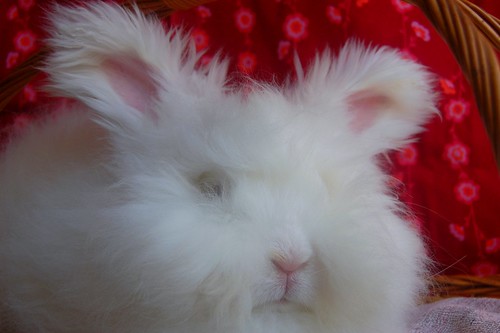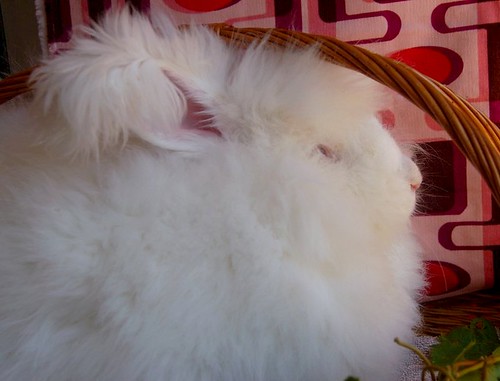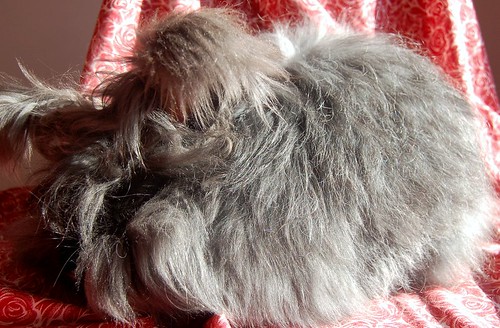I am most familiar with the North American angora classifications so this page reflects that. I am attempting to learn the European system, as well, while balancing family responsibilities and learning languages, so please forgive any discrepancies. From what I understand, European rabbit breeding associations take a different approach to classifying rabbits than what is practiced in North America. Rather than evaluating rabbit against rabbit, they set forth a standard against which each animal is judged. It is the French standard or the German standard or the Danish standard, etc. which influences the regional selection of individuals within the breed 'Angora.' During judging, each angora is compared to the standard and awarded points according to its merit in meeting that standard. At the conclusion of judging, the points are added and the rabbits with the highest points are considered to be most like the ideal rabbit described in the standard. If none of the rabbits earn a minimum number of points, then there are no winners.
English
Weight: 2.0–3.5 kg
Rabbits of the English Angora type are adorned with thick fur on all parts of the body except the nose and mouth. Their wool is fine, with minimal guard hairs, and requires brushing once a week or more to keep the coat in good condition. This is the smallest Angora rabbit of the four primary breeds, and has a very gentle, calm nature.
Our Ruby-eyed White English buck (American type,) Velveteen. He came from the US with us when we moved to Hungary, and is the first/only English Angora in this country.
French
Weight: 3.0–4.5 kg
The French type has a large amount of thicker guard hair, with fine wool as an undercoat. If the texture is correct, it requires less maintenance than other Angora breeds. Small ear tufts are allowed. It differs from the English and German Angora in that it possesses a "clean" face and front feet, with only minor tufting on the rear legs. While naturally thicker than English fur, the fiber of the French has a smooth silky texture as opposed to the fluffy English type down.
example of French type
Weight: 3.0–5.5 kg
Development of the angora in Germany was started over 80 years ago, with a primary focus on wool production and body type. Like the French type, they are bred as a dual-purpose rabbit for fiber and meat. They also have a thicker silky guard hair, with a large amount of down undercoat. The albino ruby-eyed white is most common, although different colored strains are being developed.
We are pleased to have imported yellow, black and himalayan colored angoras from Germany to develop with our albino Germans. We acquired our albino Germans from the quality imported stock of our good friend Erzsébet Gál of Made in Superior in Budapest http://madeinsuperior.blogspot.com . Ms. Gál and I also worked together to import our colored German stock from Germany in Spring of 2011. These are the first colored German Angoras in Hungary. We are expecting first litters from these rabbits this fall!

Our German buck, Dr. Bubó - he produces the most fiber of all our rabbits.
Our German doe, Ursula - she is a close second to Bubó in fiber production.
Posey, imported from Germany with Saffron. Long, silky fiber and wonderful color density. Fiber can be harvested by plucking, but I have grown it up to seven inches long if kept on the rabbit.

Yellow-gelb / fawn doe, Saffron, imported from Germany. This lovely doe has masses of lovely, crimpy fiber. She is the Queen and requires her loyal subject (me) to feed her before everyone else.(ear tassles trimmed to help her look tidy for the photo)
Satin
Weight: 2.5–4.5 kg
The Satin Angora is a relatively young breed, developed in Canada by Mrs. Leopoldina Meyer through the crossing of Satin rabbits with French Angoras. They were recognized as a distinct breed by ARBA in 1987. Ursula Glauser in Switzerland imported the first Satin Angoras to Europe in the Spring of 1998, and has done much to promote the breed here in Europe. Her website is very informative http://www.glauserweb.ch/index.htm with many pictures of her beautiful rabbits and products made from their fiber. Our Satin Angoras have their origin in the rabbits imported to Switzerland by Ms. Glauser, and were imported to Hungary with the help of Ms. Gál of Made in Superior in Budapest. Ms. Gál and I have the first and only Satins ever imported into Hungary.
The wool of the Satin Angora is finer than the wool of the other Angora breeds. The fiber is fine, soft and silky, with a good crimp to the undercoat. It appears to be 'shiny' due to the smaller diameter and clarity of the hair shaft, which provides a reflection of light that gives the hair a shining richness of color. The sheen should be evident over the entire body from nose to tail. Wool production from the Satin Angora has been improving through selective breeding, but due to the fine, delicate quality of the fiber, the Satin type does not produce as much fiber as the other angora types. The Satin gene is recessive, which makes them that much more difficult to propagate. Satin Angora fiber is one of the most rare luxury fibers.

Our beautiful young copper buck, Penny, imported from Austria.
Our chestnut agouti doe, Annie Oakley, imported from Germany.
Our new Satin doe, HH Rhapsody, imported from Hastings on the Hill rabbitry in the US.





Thank you so much for this blog. I am looking into the possibility of starting Angora Farming in GEORGIA( CIS) capital Tbilisi . I wish to take information and training from a European based set up . I would appreciate if I can have a mail communication link with you for guidance. My e mail address is pkbali at gmail dot com . I am based in new delhi india.
ReplyDeletevery cute your angora rabbits.
ReplyDeleteI'd like to buy some rabbits from you. How can I contact you?
ReplyDeleteThis is a good resource for finding satin angora rabbits for sale and adoption.
ReplyDeleteGreetings from Croatia,
ReplyDeletewe are looking for an angora rabbit breeder. Our desire is to breed angora rabbits, for exhibitions and wool. We can't be more beginners than we are. Can we contact you?
Hello, I'm from Romania. I would like to buy one or two German Angora rabbits from you. Do you have an email address or another way I can contact you? Thank you!
ReplyDelete